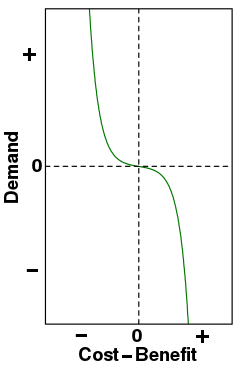 he well known law of supply and demand states that the price of some traded item
varies until the quantity demanded equals the quantity supplied.
he well known law of supply and demand states that the price of some traded item
varies until the quantity demanded equals the quantity supplied.
It's a valuable principle, but it only pertains to competitive markets, and it doesn't explain why demand rises or falls. Economists have to postulate a homo economicus who is solely concerned with purchasing and selling goods. The law also predicts that when the quantity of goods is unlimited, the price falls to zero. But this is not really true.

Cost−benefit vs. Demand curve
Consider a government laboratory, which is so well funded it can obtain as much equipment as it wants. Big organizations often have a surplus equipment department where labs can get scientific instruments for free, as they're merely transferred from one building to another, so there is no apparent cost.
The lab may be tempted to acquire an infinite amount of equipment, but it soon discovers that there actually is a cost: the equipment requires a continuous supply of spare parts, and it takes up bench space, so the cost is a decreased ability to do experiments.
And that is a disaster, because even though they can burn through their budget faster (which is the goal of every branch of government), they get less funding in the next fiscal year because they're not actually getting anything done.
So economists needed to reformulate the law of supply and demand to this: demand decreases until costs equal benefits. By costs is meant the marginal psychological cost and the total cost of ownership. Demand can be positive or negative. When demand is positive, people acquire stuff. When it becomes negative, people get rid of things.
In a marketplace, where everything is based on monetary value, this reduces to the law of supply and demand. But unlike the simpler law of supply and demand, the principle of infinite acquisition, as I prefer to call it, also explains how the demand for government services in a social welfare state is nearly infinite: the recipient does not pay for them—the costs are always borne by somebody else.
Nevertheless, there are still costs, as Laffer pointed out, though they may be delayed. If A offers to give B an unlimited quantity of free stuff, B will continue to take it until the burden of possession equals the benefit that B receives. That burden includes the cost of protecting the goods from theft, and the cost of storing and maintaining the goods. The psychological reward for obtaining stuff at no cost also decreases, because the joy of depriving someone else of the goods wears off.
When the costs are zero, as when the stuff is purely monetary, the demand is effectively infinite. Communist countries are not immune to this law: when food is free, supply, variety, and quality all decrease to restrain demand.
For government-supplied services such as free health care, the supplier would have to increase the costs by some other means, such as increasing the incidence of medical errors, greatly increased waiting times, denying treatment for certain groups, or reducing the quality of service, to reduce demand and prevent infinite usage.
You might call this a fourth law of economics, though I prefer to call it the law of infinite acquisition. Here are my candidates for the four most important ideas in economics:
- Economies are self-organizing systems (Adam Smith).
- Prices = information (Hayek).
- Prices rise until demand equals supply.
- Demand decreases until costs equal benefits.
Many others have interpreted demand as a function of marginal benefit (see here for an example). In fact, there's a whole subfield of economics called utility theory going back to 1738 based on this idea. In particular, Carl Menger's 1871 Principles of Economics formulated the idea that marginal utility is the source of value, thereby laying the foundation for the Austrian school of economics. It's a way of welding cost-benefit analysis onto the principle of supply and demand. But maybe it's also a useful way to think about how things work in a social welfare state.
Updated jun 05 2016 6:02 am
